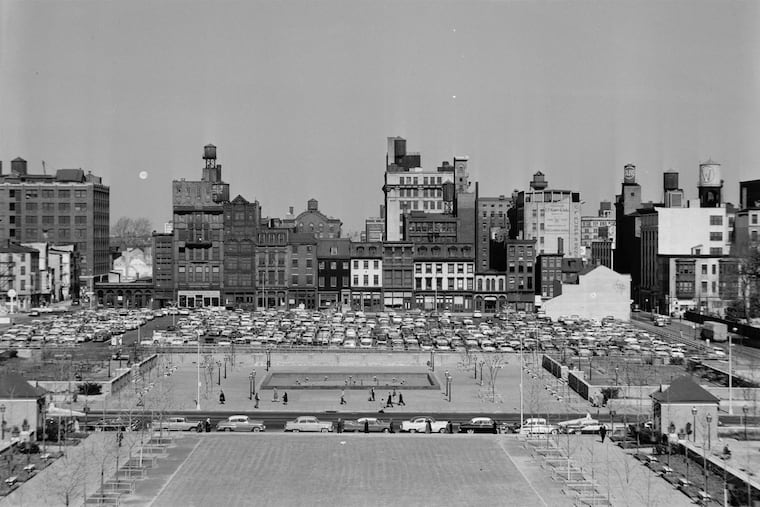How Independence Park brought drama from the start
In the mid-20th century, as a movement to beautify the faces and lift the social moods of densely packed cities with monumental projects such as the National Mall in Washington D.C., interest in Independence Hall renewed.

Nearly 250 years ago, inside the redbrick, Georgian-style structure near Fifth and Chestnut Streets in Old City, the Founding Fathers debated drafts of the Declaration of Independence and the U.S. Constitution en route to the birth of the United States.
Later nicknamed Independence Hall for its role in the country's founding, the building continued to serve as the city's political and commercial heart well into the 19th century. But how that iconic structure and its nearby blocks became part of what we now know as Independence Mall is a saga of controversy and missteps.
Throughout the early and mid-1800s, the state and city ordered several major renovations to the building and its adjoining yard — together renamed Independence Square — as Philadelphia blossomed.
But after the towering, French Second Empire-style City Hall rose at the intersection of the city's two largest thoroughfares and then officially opened in 1901, interest in the landmark waned.
In the mid-20th century, however, as a movement to beautify cities and boost civic pride with monumental projects such as the National Mall in Washington, Independence Hall saw renewed interest.
This movement helped spur the creation of Independence Mall.
1940s and 1950s
When the movement to build the destination began in the late 1940s and early 1950s, the three blocks north of Independence Hall that would become Independence Mall were a crowded maze of mixed-use buildings and alleyways.
The Pennsylvania legislature authorized the creation of Independence State Park in October 1945. An estimated 143 buildings in the area would be demolished starting in 1952, according to Inquirer archives.
But as plans were put into motion, controversy immediately followed.
Many businesses were taken by eminent domain and a number of the leveled buildings were, in their own right, significant pieces of American history, designed by architects like Frank Furness.
The development, which was a joint effort between the city and state, was marred by constantly changing design plans. An inability to work around Market and Arch Streets, which divided the area, led to a disjointed, three-section mall that took more than 25 years to complete.
1960s and 1970s
By the early 1960s, every building in the three-block mall area had been demolished, except the Free Quaker Meeting House at Fifth and Arch Streets. By 1976, all nonhistorical structures adjacent to the state park area were demolished.
In 1976, a new Liberty Bell Pavilion opened in time for the nation's bicentennial celebration.
1990s
In the 1990s, the Park Service assumed ownership of the mall, taking control from the state, and the site saw its first true redesign.
At the time, decision-makers viewed the area as a major asset in Philadelphia's revitalization efforts. Pew Charitable Trusts, a major nonprofit, led the charge, funding a new visitor center in an attempt to jump-start the city's floundering tourism industry.
A new master plan was adopted, calling for more full-time attractions along the mall's Sixth Street edge. Among the additions were a modern setting for the Liberty Bell, and the new National Constitution Center, which would serve as a northern anchor opposite Independence Hall.
The primary feature, the expansive lawn dubbed First Amendment Plaza, was outfitted with curved pathways and softer landscaping. The additions were aimed at reviving the grounds and boosting foot traffic and tourism, though that effort has been met with mixed reviews.
2001 – Today
In 2007, on a plot of land adjacent to the Liberty Bell Center at Sixth and Market Streets, the mall began construction on its newest addition: the President's House, an open-air monument to the first incarnation of the White House, where the slaveholding George Washington and antislavery John Adams conducted their presidencies from 1790 to 1800.
During excavation of the site, archaeologists uncovered the building's original slave quarters intact. A memorial was added to the final design that recognized the enslaved Africans who toiled in the face of American freedom.
While there haven't been major updates to the mall recently, the visitors' center is undergoing a two-year, $150,000 renovation. The expansion will include a new upper-level terrace, expanded gift shop, and new bathrooms. No other major forthcoming additions or changes have been made public.
This article draws on material found in the digital archives of The Inquirer and Philadelphia Daily News. *Search the archives for yourself and subscribe for full access.*